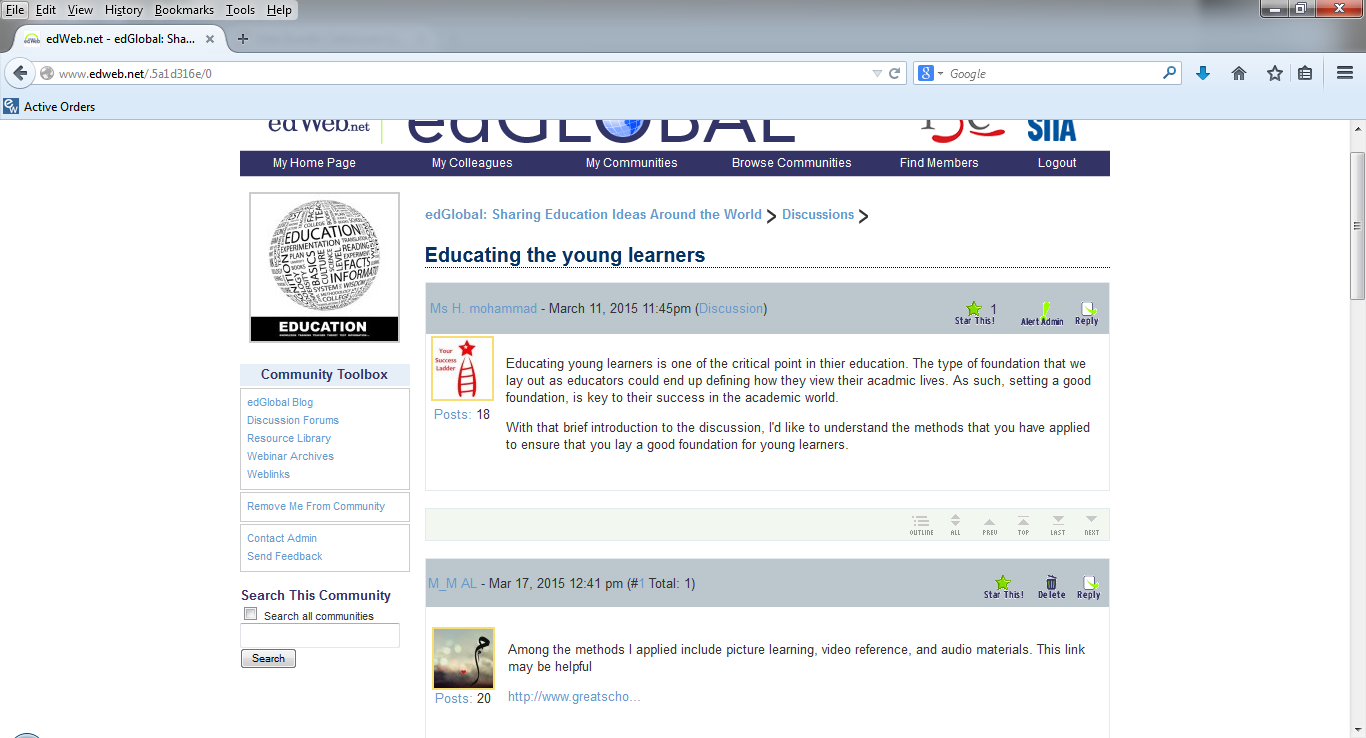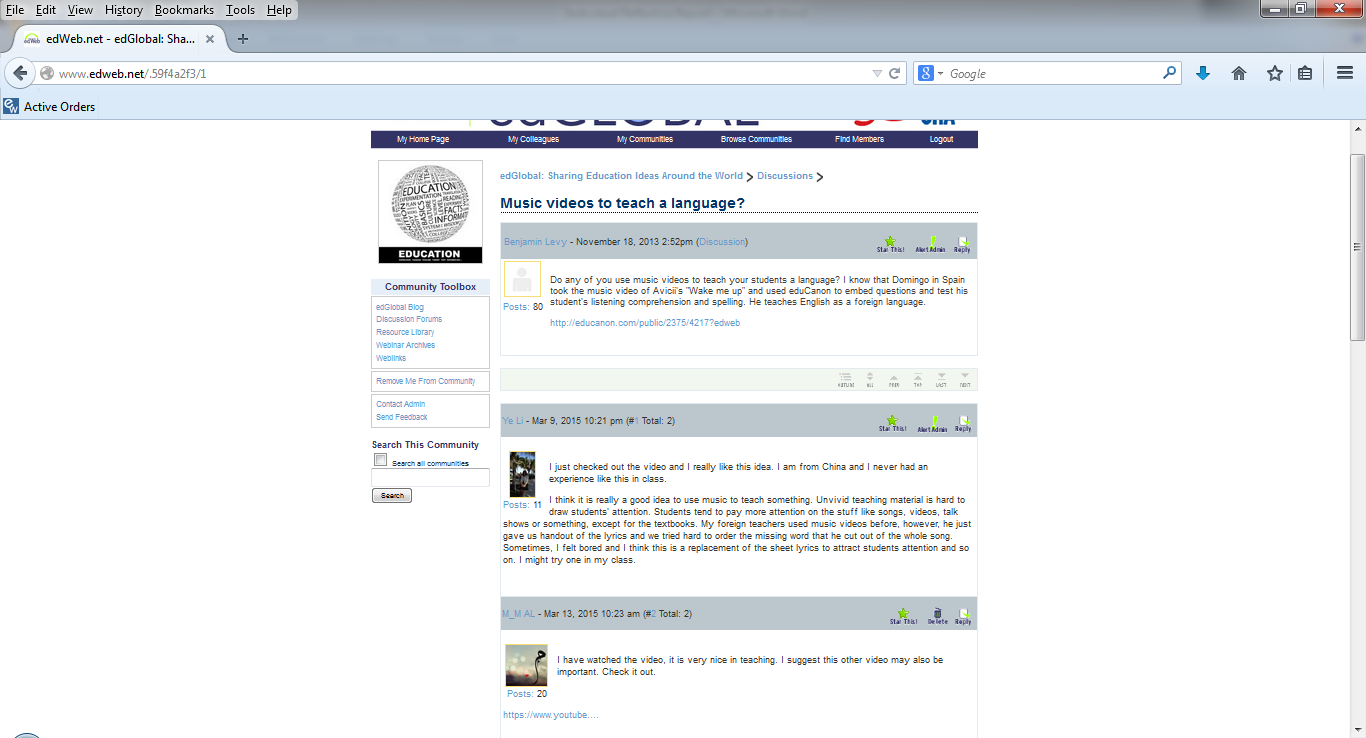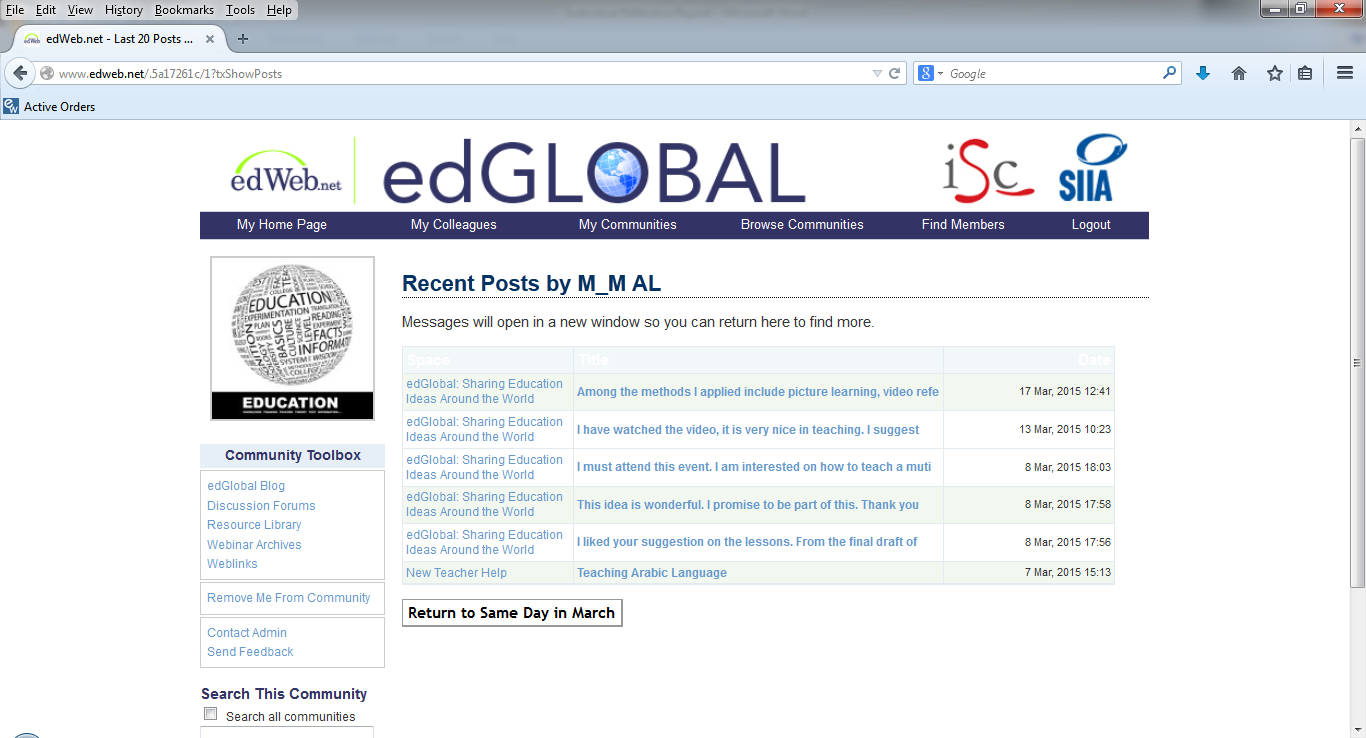Executive Summary
The two weeks of actively participate in an online community of practice that deals with sharing different ideas on education across the globe was an awesome experience. The online community, edGlobal: Sharing Education Ideas around the World, is very dynamic. The URL of the site is www.edweb.net/edglobal. The site has a following of more than 300 members. Membership is free upon creating an online account on the site. The site is ideal for an education instructor on teachers interested in understanding different methods of teaching and materials that are necessary to make the education environment lively and healthy. The site is user friendly, very interactive, and allows for open discussions that are collaborative in terms of learning opportunities. I participated in the online forum through personal blogs on instruction methods, education support materials, and strategies for effective teaching of the Arabic language in an elementary class. I also made observations and posted comments on blogs of other members. Generally, my level of engagement can be described as active and participation on the site, edGlobal: Sharing Education Ideas Around the World, was instrumental in understanding proactive learner engagement.
Introduction
Group interaction encompasses interaction among group members in the process of sharing knowledge. Group interaction has its dynamics as each member is expected to contribute to the overall learning objective. Thus, this reflective paper provides an overview of group activities, learning experiences, and group collaboration dynamics in undertaking the group online discussion forum. Specifically, the paper reviews an online community blog called the edGlobal: Sharing Education Ideas Around the World in terms of personal participation, experience, functionality, and lessons learned.
edGlobal: Sharing Education Ideas Around the World
Brief description of the site
The site, edGlobal: Sharing Education Ideas Around the World, is an online learning blog for education professionals interested in learning flexible education initiatives through the exchange of teaching ideas across the globe. The URL of the site is www.edweb.net/edglobal. The online community consists of government officials, administrators, and officials interested in understanding different education concepts and their application in the learning environment (Bernard, Abrami, Lou, Borokhovski, Wade, Wozney, Wallet, Fiset, & Huang, 2004).
The rationale for selecting the site
I selected the site since it has a global following beside a series of good ideas on education. For instance, the members have posted a lot of information on teaching practice, approach, and materials that support open learning. Since I am an Arabic language teacher, I found the site very useful in sharing and grasping new concepts in the classroom environment.
Evaluation of the CoP
Usability
The site is very easy to use since it has a self-explanatory manual for interested members of want to join the forum. Upon creating an account, a user can easily create blogs and post them since the upload and editing buttons as very easy to use. Also, the CoP has the option of uploading different materials as attachments or references for a single blog. Any user who is computer literate would find the site simple since it is modified to accommodate multiple activities on a single page (Allen, 2005). Members’ exposure to the format of online sharing does encourage them to strive to gain a basic user’s proficiency in the field of informational technologies since the site has interesting features.
Interactivity/Sociability
The CoP facilitates the creation of a community among members through encouraging online sharing of education initiatives among parties interested in the topic of global education. The site has a free membership tag and a lot of materials that any targeted member would find interesting. Besides, the CoP has several meaningful collaborative learning opportunities such as direct participation in upcoming events, commenting on different blogs, and making suggestions on each topic or blog posted by a member (Bernard et al. 2004).
Participation and engagement with the CoP
Social presence
I established a social presence in the education blog through the creation of a profile that introduces me as an experienced Arabic language teacher with an interest in sharing education initiatives. After the creation of the profile, I employed the profile booster tool in the site to increase my visibility and identify members with the same interests. This was followed by the creation of a mini group through the invitation of other members to join in my discussion forum (Allen, 2005). After three days of active membership, I was able to track the performance of my posts using the viewership tracker tool. In the end, I managed to create a distinctive presence as an equal contributor to different materials posted on the CoP. Most of the participants had avatar names and real names. The avatar name is meant to enable other users to easily recall resent members who have participated in their blogs.
New member engagement
As a new member, I have deeply involved in building the presence of my profile through invitation and posting of a series of documents, links, and attachments. My nature of participation as a new member was posting a series of short responses and suggestions on blogs of existing members. The first paper I uploaded was on teaching basic Arabic language in an elementary class environment. This was followed by a document outlining a lesson plan that incorporates videos and pictures in teaching. The first response I post was a suggestion to a blog on teaching tools that guarantee good results. I suggested the incorporation of a video available online as part of that blog. I also offered to participate virtually in one of the events that a member sent invitations to the community. I asked for ideas among the community members on the best approach that I may use to teach basic Arabic language under the open forum section. In the two weeks of participation, I was active in providing support for other colleagues through making suggestions on their posts. I was also able to post four documents that attracted several stars and comments. I noticed that a member of the community created a link to my post of teaching the Arabic language as one of her references. The below screenshots summarize my participation.


Details of specific participation
In the CoP, I intend to address the concerns of language teachers in the classroom since in encoding and decoding information, it is critical to balance the concepts and appropriateness of the education strategies. The first post I did was on a lesson plan for teaching the Arabic language in the elementary classroom environment. The lesson was intended to promote audio, visual and interactive learning. Therefore, I critically endeavored to balance the feedback with the goals of the lesson as a remedy towards inclusiveness and active participation (Allen, 2005).
The second post was on factors influencing early childhood learning. The post was meant to describe the process of early childhood learning and relate the same to my interest in teaching the Arabic language. Among the factors, I identified include community services such as support for parenting, housing qualities, community safety and security, unemployment, social crimes, and a general feeling of trust among the residents’ influence children’s growth and development. These coupled with different cultures, parenting styles, beliefs, values, and different perspectives of children influence the development and early childhood development. Understanding these facets puts early childhood development into perspective, thus improving the chances of successful development (Ramage, Bean, & Johnson, 2006).
The third post was on the flexibility of the teaching environment. Notably, the inclusion of bright colors in the learning process is apparent to have attracted the attention of young learners. The level of student engagement was interactive. Free interaction created a suitable learner-centered environment during the 45 minutes lesson. The first instructional variable was the introductory focus which entailed attracting the attention of students. The second variable was linking the topic to the students’ lives. Among the notable comments, I posted online on a similar topic discussed by another member was that a teacher must use visual aids in the delivery of the contents to ensure that theory is supported by the practical learning experience. The décor of the classroom must also be appealing to the level of the learners, especially with bright colors since young learners find it comfortable to study in a warm environment (Ramage, Bean, & Johnson, 2006).
The students must also be taught to be responsible through the concept of rotation of roles among the learners. In the last comment I posted in a discussion appropriate delivery method in a dynamic classroom environment, I argued that a teacher’s delivery of the rules should include the use of personal freedom and control (Allen, 2005). For instance, the learners should be told what they should be able to do and how it should be done. Although students are not involved much in the rulemaking, they must be made to feel that their safety and success is in their hands to ensure that the learning process is healthy (Ramage, Bean, & Johnson, 2006). I also posted several comments in response to initiatives proposed by other members of the community. This is summarized in the screenshot below.

Evaluation of participation
Evaluating the level of engagement
I was very active in the online community discussions across the two weeks. Each day, I posted a comment or response to numerous articles published by other members. I also initiated a discussion with three different articles dwelling on teaching methods that can be applied in the elementary classroom environment. By the end of the period of participation in the online community, I was able to post twenty contributions to the CoP. Despite being a relatively new member, I received several private emails from other members who wanted my input in their posts. Besides, I received an invitation to four discussion boards that are managed by the administrators. As indicated in the online community policy, invitations to such discussion boards are only sent to the most active and resourceful members.
Factors that facilitated or inhibited participation
No factor inhibited my participation since the site was very easy. Several factors facilitated my participation. To begin with, sharing the same education views with other members was a motivating factor towards posting a series of articles on the site. Besides, the CoP was user friendly in terms of the buttons for posting, editing, and performing other duties while participating in the online education community (Knowles, Holton, & Swanson, 2005). The administrators of the online community have optimized the search engine for different documents within the site. Search engine optimization was achieved through installing ‘plugins’ that possess extra features such as page navigation and thumbnail within the website. Specifically, this system consists of a multi-tab page that serves different areas and services to members by a click of a button (Allen, 2005). Besides, optimizing the link referral has the potential of making the users edit and customize the posts at will without having to constant the administrators. The site has also been tailored to include a unique cookie that is transferable to members who join different discussion groups (Ramage, Bean, & Johnson, 2006). The unique cookie for the website is transferred to all primary and secondary visitors of this site hence broadening the spread information among members. These features make the site user friendly and ideal for holding online forums (Knowles, Holton, & Swanson, 2005).
Actions of members that contributed to social presence
More than four members recommended some video and document links to vital materials that may form part of the visual educational initiative. As a result, the links were very instrumental in enhancing my social presence since they formed the basis of my articles and respond to posts by other members.
Overall evaluation practical uses and value addition of the CoP
I observed that the cognitive perspective influences contribution from each member of the group unequivocally for learning at the individual level while the cultural perspective, on the other hand, focuses on learning on a collective level. However, I learned that the basic problem that arises from the application of group engagement is the fact that it is not possible to see cognition occurring in a group of different individuals doing the same activity. Group collaboration dynamics are influenced by several factors such as motivation, promotion, and structured feedback system that an assignment requires. Participation in the site, edGlobal: Sharing Education Ideas Around the World, has been instrumental in boosting personal confidence and widening my scope in terms of education initiatives that I can apply in teaching the Arabic language in an elementary classroom environment.
Conclusion
The two weeks’ experience a member of the online educational sharing community site, edGlobal: Sharing Education Ideas Around the World, was very educational. The experience was an eye-opener on the most appropriate teaching initiatives that are ideal in the elementary classroom environment. The initiatives I learned include the use of visual objects, proactive participation, audio materials, and the creation of a healthy and warm learning environment.
References
Allen, J. (2005). Seizing the Opportunity: the Quality and Extent of Online Education in the United States, 2002 and 2003. Needham, MA: Sloan.
Bernard, R., Abrami, P., Lou, P., Borokhovski, E., Wade, A., Wozney, L., Wallet, P., Fiset, M., & Huang, B. (2004). How does distance education compare with classroom Instruction? A meta-analysis of the empirical literature. Review of Educational Research. 74(3), 379-439.
Knowles, M., Holton, E., & Swanson, R. (2005). The adult learner (6th ed.). New York, NY: Elsevier.
Ramage, J., Bean, J., & Johnson, J. (2006). Writing Arguments: a Rhetoric with Readings, London, UK: Longman.